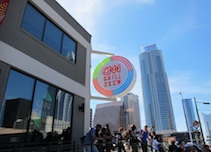
Now that the interactive portion of the SXSW conference in Austin, Texas is over, the key question is already rolling in: who won?
What this really means, of course, is: what service was the breakout hit of the conference? After all, in past years, the conference has helped launch both Twitter and Foursquare into widespread usage. So the question really is: who was this year’s Twitter? Or what was this year’s Foursquare?
The answer this year is a bit different, a little disappointing, and perhaps not all that surprising.
While all the hype leading up to the conference focused on the red-hot mobile group messaging space, the real “winners” of SXSW 2011 were advertising, marketing, and branding — oh yes, and the iPad 2.
Bleh, I know. But absolutely true. Everywhere you turned at the conference, an insane amount of advertising is what you saw. And that’s what people were talking about. Well, when they weren’t talking about the iPad 2. Or waiting in line at the brilliant pop-up Apple store to buy one.
Don’t get me wrong, a number of the group messaging apps like GroupMe, Beluga, Fast Society, Yobongo and others undoubtedly saw record numbers that I’m sure we’ll be hearing about shortly. But in talking with other attendees throughout the show, the consensus was clear: there was no consensus winner among those apps. Some people preferred one, some preferred another. And some preferred none at all — they simply networked the old fashioned ways: those being yes, Twitter and Foursquare.
But everyone agreed that the amount of corporate and startup advertising and branding going on this year was amazing — not necessarily in a good way, just in a way that you had to talk about. Just look at some of the images above and below.

There was a nifty foursquare court (as in, the actual game run by the company) area that was one giant Pepsi Max ad. We had a GroupMe taking over a big grill house. CNN took over an entire Austin bar and completely rebranded it — complete with a big glowing, rotating sign. Uber took over a hundred or so pedicabs. Even our parent, AOL, took over a huge portion of the conference center for a TV studio that we used. The list goes on and on.
Obviously, marketing and branding has always been a big part of SXSW. But this year was exponentially beyond anything seen in years past. Some conference-goers compared it to Disneyland. But it was actually much worse than Disneyland. It was Disneyland if they had rides with names like: It’s A Small Red Bull World.
That’s not necessarily to say that any of this had an adverse affect on the conference itself. In fact, all the sponsorships meant more parties than ever before, more free food and drinks than ever before, and enough free shit — er, schwag — to clothe a small nation.
And when the discussion wasn’t about the crazy advertising at the conference, it was about the iPad 2. People who had them were constantly showing them off everywhere you looked. Meanwhile, everyone was either talking about the pop-up store that Apple set up on sixth street just to sell the product (and its magnetic cover), or they were standing in line to get in the store.
I walked by the store each day. There was home to a constant, often massive group of people waiting to get inside to buy one. Some walked away with the one they wanted, others walked away with any one they could get.
At one point, I stopped by the store just in time to hear an employee telling those in line that unfortunately, they only had one model left in stock: the white, 64 GB, WiFi version. Almost no one got out of line. I think employee could have said that all remaining models had broken screens and the reaction would have been the same. People wanted the thing, no matter what.
When we look back, I think we’ll recognize SXSW 2008 as the year of Twitter, SXSW 2009 as the real year of Twitter (and the launch of Foursquare), SXSW 2010 as the year of Foursquare, and SXSW 2011 as the year of branding, advertising, and the iPad 2. A little unconventional, yes, but that’s the way it was.
















